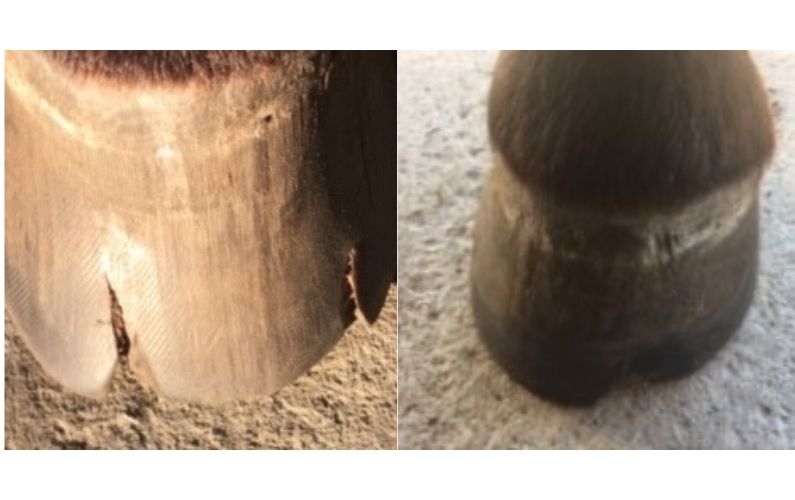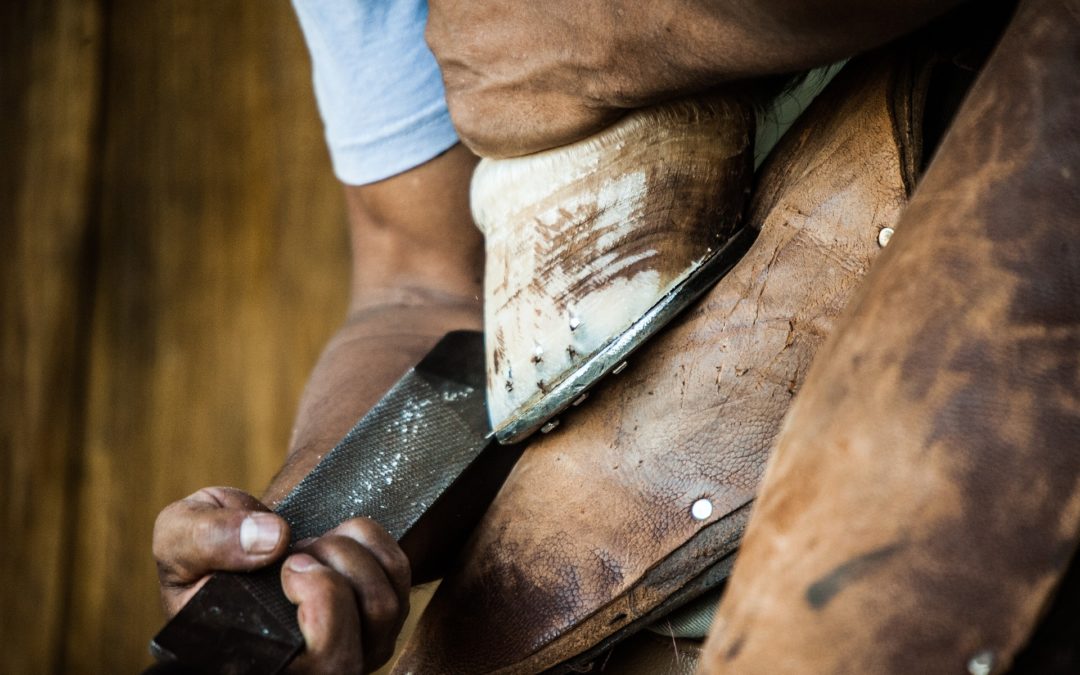This post may contain affiliate links. Please read our disclosure for more info.
Taking good care of your horse’s feet is a very necessary part of horse ownership. It is not difficult, but it does require consistency. There’s an old saying in the horse world, “no foot, no horse”. This is so true. You can have a horse that appears perfectly healthy, but if they have a serious issue with their feet, they can actually lose their life over it.
Here are 3 Tips that you will want to include in your routine with your horse.
Tip # 1 – Find a Great Farrier
Horses that are confined to stalls or pastures, have less opportunity for natural wear on their hooves. I can’t emphasis enough how important it is to find a good farrier. All farriers are not created equal! A horse’s hoof will grow long enough to replace itself in a year, therefore it’s important to have a farrier visit your horse for regular trims and/or shoe resets every 6 weeks or so.
Traits of a Good Farrier
A good farrier will ensure that the foot in not only trimmed, but balanced. They will take the time to evaluate each individual foot of each individual horse. your horse as they make their way around your horse.
A balanced hoof allows the horse to move better and puts less stress and strain on bones, tendons and ligaments. Hoof balance is also very important in preventing hoof issues, such as cracking. The pictures below are of one of my horse’s hooves last year. I hired a poor farrier that didn’t know how to balance my horse’s foot, hence the deep toe cracks that developed quite quickly. At first I didn’t realize that his trimming was the cause of the issue. As the cracks got progressively worse, I finally found a different farrier and voila, the cracks are gone.

A good farrier will be passionate about what they do and passionate about getting it right. They care about the balance of the foot and view their work as art as much as science. They will treat your horse with kindness and respect.
A good farrier will be experienced in shoeing for the event you are participating in. If you ride dressage, you will want a farrier experienced in shoeing dressage horses. If you are a reiner, you will want a farrier experienced in shoeing reining horses. Ask for recommendations amongst your fellow competitors for recommendations on good farriers.
Tip # 2 – Inspect Your Horse’s Feet Regularly
As simple as it sounds, one of the best things you can do for your horse’s hooves is simply to inspect them thoroughly and regularly, preferably every day. You’ll become much more apt to notice changes or problems early, when they are easier to address. Picking out his feet will allow you to see if any rocks or sticks are lodged in his foot and also observe the health of the frog.
One condition you definitely want to catch early is thrush. Thrush is an anaerobic bacterial infection that penetrates the soft tissues of the foot, particularly around the frog. It’s known for its black discharge and strong smell.
Thrush requires moisture to grow, and it has long been associated with poor hygiene. But many factors contribute to its development, and some horses who are perfectly well cared for may develop thrush when the pasture is wet for more than a few days. If your horse is stalled, be sure that his bedding is kept clean and dry.
Treatment for Thrush
With early treatment and good stall and environmental management, the prognosis for complete recovery for cases of thrush is good. Treatment will usually be required for 7-14 days. Most thrush organisms are extremely susceptible to antibacterial solutions.
If you discover the beginnings of thrush, scrub the foot really good with a stiff brush and an antibacterial soap. Then apply an antibiotic solution. Commercial products are available such as Thrush Buster, but a diluted solution of iodine works as well as anything.
Tip # 3 – Nutrition and Your Horse’s Hooves
Feeding good quality hay, supplementing the appropriate amount of vitamins and trace minerals, and making sure the horse has constant access to fresh, clean water is important for hoof health and overall horse health. Poor nutrition can lead to future hoof problems, and correcting a horse’s nutrition can gradually improve hoof health. Cooperation between horse owners, veterinarians and equine nutritionists is needed to ensure proper horse nutrition.
Research has shown that horses with poor quality hooves can benefit from commercially available hoof-care products that contain biotin, methionine and zinc
- Biotin: Perhaps the most researched vitamin for hoof growth is Biotin. Biotin is thought to help with hoof integrity as well as coat, mane, and tail growth. Studies have reported varying effects, but horses with poor hoof quality despite a balanced diet and favorable environment might benefit from a therapeutic dose of biotin. Research indicates a therapeutic dose of biotin to be 15 to 20 milligrams per day.
- Methionine, an essential amino acid, is thought to be important for hoof quality. However, balance is key. If fed in excess, methionine is also believed to cause a depletion of iron, copper, and zinc. This can lead to crumbling horn and white line disease. The hoof structure is primarily made of keratin, a protein. Proteins are made of amino acids and are necessary for healthy hooves and growth.
- Zinc: Zinc is necessary for normal keratinization of the hoof. Studies have shown that horses with insufficient hoof horn strength had less zinc in the hoof horn than horses with healthy, undamaged horns.
What to Do if Your Horse Won’t Let You Pick Up His Feet
If you are having trouble with your horse when you try to pick up his feet, there are probably other things going on with your horse besides his feet. You may need to take a step back and begin to work with your horse on basic ground training so that your horse gets used to you working around him and his feet and legs. The time to do this is not an hour before the farrier is due to arrive.
Horses become comfortable with things that you do all the time, that they know won’t hurt them. Make hoof handling part of your regular routine. If you pick out and otherwise handle your horse’s feet frequently, farrier work won’t seem too foreign to him. It pays to just make this a part of the daily grooming routine.
Even if your horse is too young to be ridden, make a habit of picking the feet up and tapping on them every time you groom them. This can make a big difference as the horse gets older.
Horses who aggressively resist having their feet handled pose a serious challenge, one that goes beyond simple retraining exercises. This behavior may result from a previous bad experience, inadequate training or, simply, a disagreeable temperament. Whatever the cause, the solution more often than not requires the help of one or more professionals.
A trainer, for example, may be able to work through certain issues or help you work through challenges with your horse to safely change his attitude about having his feet picked up, trimmed and shod.
For the Older or Senior Horse
If you have an older horse, make sure that he is not hurting. Injury, arthritis, stiff muscles or other sources of soreness may make it difficult for a horse to shift his weight to three legs or to raise his hooves off the ground. If your horse seems to be having trouble, talk to your veterinarian about a possible physical cause. If one is found, let your farrier know so he can adapt shoeing sessions—perhaps by allowing more frequent breaks—to make them easier on your horse.
Conclusion
Since most horses have different hoof issues and growth, a good working relationship with a farrier and veterinarian is needed to ensure a healthy, sound hoof and horse. Many different foot problems can occur in horses. To reduce hoof problems, follow these important recommendations:
- Regular trimming or shoeing and maintaining good hoof balance
- Appropriate treatment if disease occurs
- Maintain proper horse nutrition
I hope you found this article helpful. If you are in the market for your first horse or your next dream horse, then you will want to get my free Dream Horse Buyer’s Guide! It’s a comprehensive guide chock full of everything you need to narrow your search and select your next equine partner. Click the button below and get it today!
Enjoy the Ride!




Hello this was very helpful. I’m a farrier and one of my clients had a bad farrier before so now I’m trying get horses feet back the way they are suppose to be.
Becky, Thank you for your comment. You know, I’ve been looking at horse’s feet for 50 years and I knew that he had left those toes too long, yet I said nothing for several months. Lesson learned, trust yourself. We know our horses best!
Pam
I recently found out that my farrier was the original owner of my 22 year old quarter horse. My gelding has had a small crack in one hoof for years by the farrier knows it well and keeps it in check without the need for shoeing. Farriers and librarians rule the world!
Cathy, yes good one’s do! Thank you for your comment!
Pam